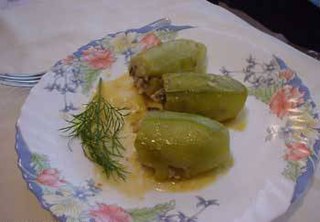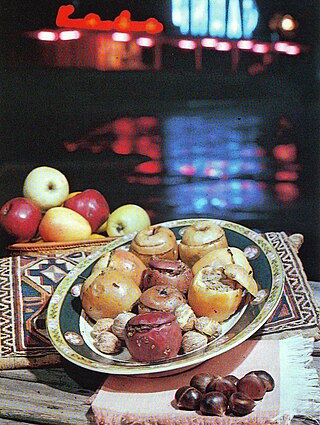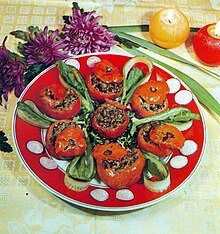
Tomato sauce can refer to many different sauces made primarily from tomatoes, usually to be served as part of a dish, rather than as a condiment. Tomato sauces are common for meat and vegetables, but they are perhaps best known as bases for sauces for Mexican salsas and Italian pasta dishes. Tomatoes have a rich flavor, high water content, soft flesh which breaks down easily, and the right composition to thicken into a sauce when stewed without the need of thickeners such as roux or masa. All of these qualities make them ideal for simple and appealing sauces.

Turkish cuisine is the cuisine of Turkey and the Turkish diaspora. It is largely the heritage of Ottoman cuisine, which can be described as a fusion and refinement of Mediterranean, Balkan, Middle Eastern, Central Asian and Eastern European cuisines. Turkish cuisine has in turn influenced those and other neighbouring cuisines, including those of Southeast Europe (Balkans), Central Europe, and Western Europe. The Ottomans fused various culinary traditions of their realm taking influences from and influencing Mesopotamian cuisine, Greek cuisine, Levantine cuisine, Egyptian cuisine, Balkan cuisine, along with traditional Turkic elements from Central Asia, creating a vast array of specialities. Turkish cuisine also includes dishes invented in the Ottoman palace kitchen.

Kebab or kabob is a type of cooked meat dish that originates from cuisines of the Middle East. Many variants of the category are popular around the world, including the skewered shish kebab and the doner kebab with bread.

Fried rice is a dish of cooked rice that has been stir-fried in a wok or a frying pan and is usually mixed with other ingredients such as eggs, vegetables, seafood, or meat. It is often eaten by itself or as an accompaniment to another dish. Fried rice is a popular component of East Asian, Southeast Asian and certain South Asian cuisines, as well as a staple national dish of Indonesia. As a homemade dish, fried rice is typically made with ingredients left over from other dishes, leading to countless variations. Fried rice first developed during the Sui Dynasty in China and as such all fried rice dishes can trace their origins to Chinese fried rice.

Dolma is a family of stuffed dishes associated with Ottoman cuisine, and common in modern national cuisines of regions and countries that once were part of the Ottoman Empire. Some types of dolma are made with whole vegetables, fruit, offal or seafood, while others are made by wrapping grape, cabbage, or other leaves around the filling. Wrapped dolma are known as sarma. They can be served warm or at room temperature.

A cabbage roll is a dish consisting of cooked cabbage leaves wrapped around a variety of fillings. It is common to the cuisines of Central, Northern, Eastern and Southeastern Europe and much of Western Asia, Northern China, as well as parts of North Africa. Meat fillings are traditional in Europe, and include beef, lamb, or pork seasoned with garlic, onion, and spices. Grains such as rice and barley, mushrooms, and vegetables are often included as well. Fermented cabbage leaves are used for wrapping, particularly in southeastern Europe. In Asia, seafoods, tofu, and shiitake mushrooms may also be used. Chinese cabbage is often used as a wrapping.

Iraqi cuisine or Mesopotamian cuisine is a Middle Eastern cuisine that has its origins from Sumerians, Akkadians, Babylonians, Assyrians and the other groups of the region.

Sofrito, sofregit (Catalan), soffritto, or refogado is a basic preparation in Mediterranean, Latin American, Spanish, Italian and Portuguese cooking. It typically consists of aromatic ingredients cut into small pieces and sautéed or braised in cooking oil.

Assyrian cuisine is the cuisine of the indigenous ethnic Assyrian people, Eastern Aramaic-speaking Syriac Christians of Iraq, northeastern Syria, northwestern Iran and southeastern Turkey. Assyrian cuisine is primarily identical to Iraqi/Mesopotamian cuisine, as well as being very similar to other Middle Eastern and Caucasian cuisines, as well as Greek cuisine, Levantine cuisine, Turkish cuisine, Iranian cuisine, Israeli cuisine, and Armenian cuisine, with most dishes being similar to the cuisines of the area in which those Assyrians live/originate from. It is rich in grains such as barley, meat, tomato, herbs, spices, cheese, and potato as well as herbs, fermented dairy products, and pickles.

Sarma, commonly marketed in the English-speaking world as stuffed grape leaves, stuffed vine leaves, or stuffed cabbage leaves, is a food in Southeastern European and Ottoman cuisine made of vegetable leaves—such as cabbage, patience dock, collard, grapevine, kale or chard leaves—rolled around a filling of grains, minced meat, or both. Sarma is part of the broader category of stuffed dishes known as dolma.

Jollof, or jollofrice, is a rice dish from West Africa. The dish is typically made with long-grain rice, tomatoes, onions, spices, vegetables and meat in a single pot, although its ingredients and preparation methods vary across different regions.

Picadillo is a traditional dish in many Latin American countries and the Philippines. It is made with ground meat, tomatoes, and also raisins, olives, and other ingredients that vary by region. It is often served with rice or used as a filling in dishes such as tacos, savory pastries or croquettes. The name comes from the Spanish word picar, meaning "to mince".

Sephardic Jewish cuisine is an assortment of cooking traditions that developed among the Sephardi Jews.

Stuffed peppers is a dish common in many cuisines. It consists of hollowed or halved peppers filled with any of a variety of fillings, often including meat, vegetables, cheese, rice, or sauce. The dish is usually assembled by filling the cavities of the peppers and then cooking.

Stuffed squash, courgette, marrow, mahshi, or zucchini is a dish common in the region of the former Ottoman Empire from the Balkans to the Levant and Egypt, a kind of dolma. It consists of various kinds of squash or zucchini stuffed with rice and sometimes meat and cooked on the stovetop or in the oven. The meat version is served hot, as a main course. The meatless version is considered an "olive-oil dish" and is often eaten at room temperature or warm.

Gambian cuisine is part of West African cuisine and includes the culinary practices and traditions of the nation of The Gambia. Common ingredients include fish, rice, peanuts, tomato, black-eyed peas, lemon, cassava, cabbage, salt, pepper, onion, chili, and various herbs. Oysters are also a popular food from the River Gambia, and are harvested by women.

Stuffed apples are made of apples stuffed with meat (lamb) and rice. The ingredients typically include green apples, minced meat, rice, onion, tomato paste, parsley, mint, cinnamon, salt, black pepper, and vegetable oil.

Stuffed eggplants are a dish typical of many countries.


















